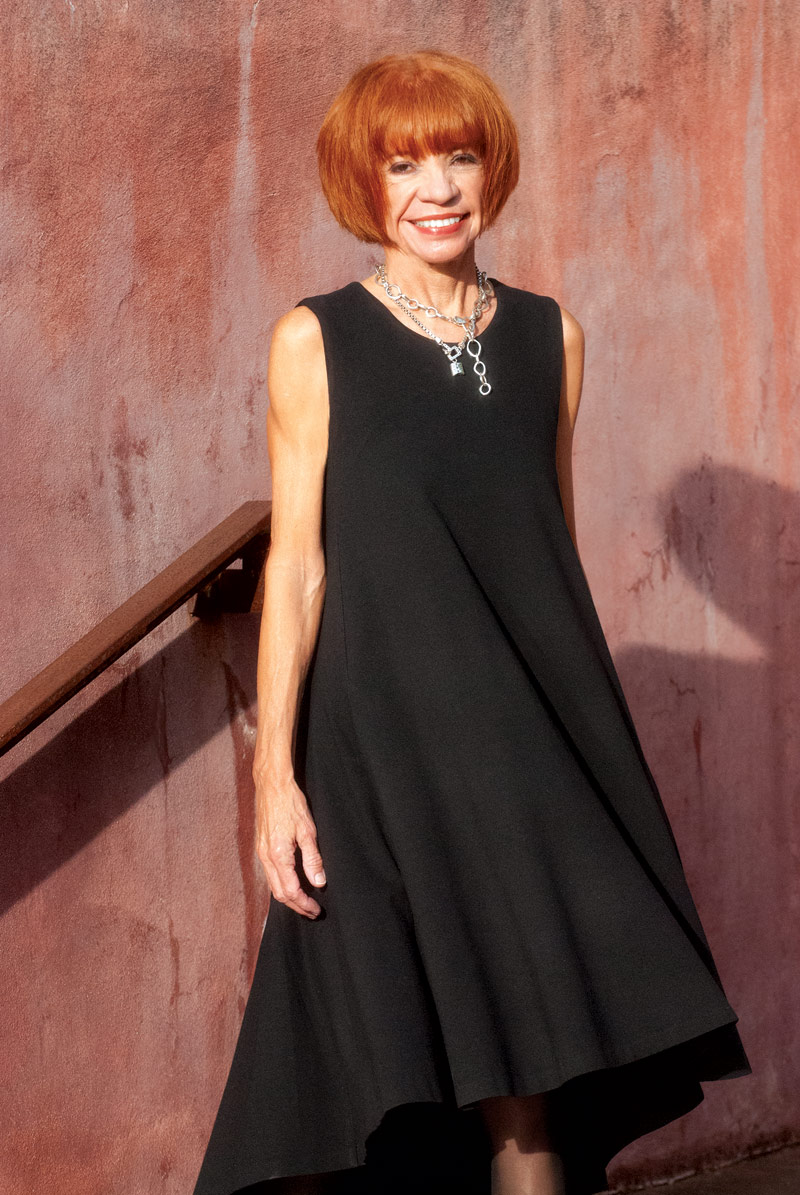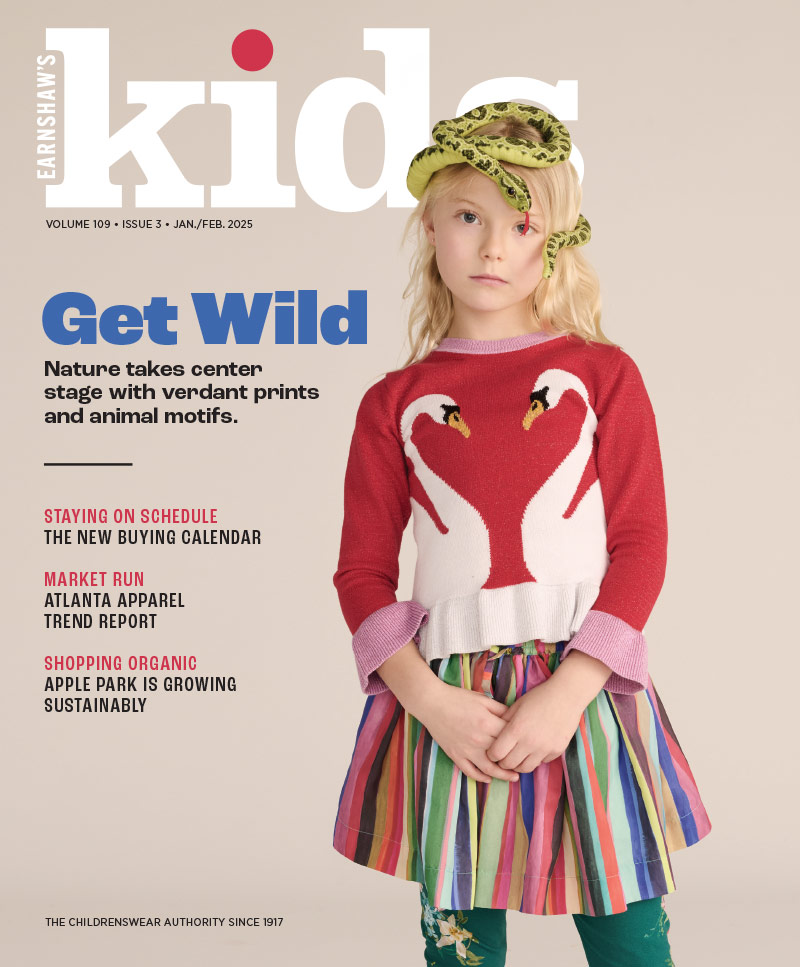How Biscotti and Kate Mack Founder and Designer Bernadette Reiss caters to fashionable girls.

Bernadette Reiss
It is fitting that Earnshaw’s should profile Biscotti and Kate Mack Founder and Designer Bernadette Reiss in this month’s Earnies’ issue. Her company has won an Earnie Award 15 times for both swimwear and dresses since the magazine first handed out the award 39 years ago. That’s a remarkable track record leading the designer to quip, “You’d think we were a big company.”
Biscotti has a wide reach. Located in Oakland, Calif., the brand has morphed into a business with 1,000 retailers worldwide and has further international expansion plans in its sights. With a penchant for beautiful fabrics and eye-catching details, Biscotti has tapped into fashion-conscious young teens and their mothers, some of whom are Katie Holmes, Victoria Beckham and Heidi Klum.
Chat Room
Whom would you invite out for a beer, dead or alive?
I’ll say my husband and business partner, Bob. He’s very much alive. We’d probably talk about what happened during the day at Biscotti. His world is keeping things going in the current season, and I’m working on the next season. Sometimes we get confused about which season we’re talking about, but we get it worked out.
What would people be surprised to know about you?
Before I started Biscotti, I had two small companies in my early 20s designing young women’s dresses. I went to medical school, but I really didn’t have the stomach for it. I was in an anatomy class, and it was the day that a cadaver was going to come out of the closet behind me, and that was the day that I resigned from that idea.
What’s on your iPad?
I read the Wall Street Journal, a local San Francisco paper, The New Yorker and The New York Times. I also have a big sprawling novel called The Corrections by Jonathan Franzen.
Reiss is one of those creative types who doesn’t just love to create, she has to. It was clear early on in her career that she would abandon her background as a psychology major at U.C. Berkeley and medical school for a life of fashion.
“I don’t think I really had a choice,” she says. “I was destined to be a designer every since the age of 9. I would think about my clothes for school, put outfits together and set trends with my friends. I loved to surprise people and be the first to risk a new look.”
Reiss founded Biscotti in 1986 as a line of separates inspired by a trip to Italy. Having recently given birth to a daughter with husband Bob Mack, she mused that clothing in Europe far surpassed that in the U.S. and modeled a business plan upon sophisticiated fashionable clothing.
By 1989, Biscotti was thriving, outgrowing an 8,000-square-foot factory for a 50,000-square-foot space. It was at that time she convinced her husband, a doctor, to retire from running an emergency room and join her team. He did. “He still has his license and people at Biscotti still come to him with little questions about their health,” says Reiss. “He likes taking care of people.”
In 2001, sister brand Kate Mack, named for her second daughter (her first daughter is Amber Reiss-Holt) burst onto the scene with swimwear, dresses and outerwear.
Earnshaw’s caught up with Reiss to talk about childrenswear, the thrill of Malia Obama wearing a red taffeta Biscotti dress to her father’s first Democratic National Convention and the company’s new baby division called Lait-ETTE.
How did you get into the apparel business?
I was living in Berkeley, and there was a store I loved called Yarmo that carried dress designer Karen Alexander. Her dresses channeled my taste in some kind of profound way. I remember thinking, ‘If I design dresses, this would be exactly what I would do.’ I found myself getting the designer’s name and phone number, calling her and asking if she could design my wedding dress. I was planning to get married. She said, ‘Sure. Come on down. I’ll design it for you, but it’ll be part of my holiday collection, if that’s okay.’ I agreed. She invited me to her factory and studio in West Oakland, which was in this old barely-renovated fire station. You walked in, and there was this big cage with a gorgeous parrot in it, and it was this whole little world—a sanctuary for design, production and shipping. Meeting her and seeing her operation sent me over the moon. I was totally sold on the fact that somehow, some way, I would thrive on designing and running a business like hers. The funny thing about it is her daughter now works for me. She’s on our design team.
Why did you get into childrenswear as opposed to womenswear?
My early experience as a designer was in fun and trendy junior and contemporary dresses and sportswear. I spent a month traveling in Italy where I was dazzled by the fashionable children’s clothing. In 1983, the children’s market in the United States was very basic. There was no tailoring, no fashion, no design—nothing cute. The cutest thing was OshKosh overalls. I thought I could offer some fresh and creative ideas that would resonate with buyers, mothers and kids. I thought to myself: ‘Let’s see what happens.’ I remember sending my sketches to the Saks Fifth Avenue buyer in advance of showing my first collection in New York. I got an appointment, and Saks grew into a very big account for us.
What was the vision for Biscotti at the beginning?
Biscotti actually started off as a very dressy separates collection. The second season, I did all dresses. It was a very small company back then. I was working out of my house, and I had three employees, so it was a good opportunity to explore the right balance of product.
What did Kate Mack offer the market that was different from Biscotti?
Kate Mack was launched in 2001 with a swimsuit collection. We incorporated the girly details and Biscotti-like dimensional applications—climbing vines and flowers, tutu skirts on the suits—the novelty of it was a hands-down breathtaking success. People hadn’t seen tutus on swimsuits before. Parents told us their little girls were sleeping in their swimsuits. The fun part was doing something new and untested that resulted in a resounding success at wholesale and retail. For the winter season, we designed outerwear and sportswear—again reflecting the romantic vision and styling that permeated our dress and swim divisions.
How big is the company now?
We have about 44 employees. We have our own warehouse, and we do all the designing here in Oakland. I have a team of four designers plus a graphic artist. I also have sales merchandisers that help review and edit our collections. Another member of our team is our pre-production person who helps us execute embroideries and other creative ideas in a way that’s marketable and can be produced without any problems. Sometimes we come up with some really incredible ideas, and it takes quite a while working through how they are going to be executed. Embroidery might look great on a size 5, but it also has to adapt to a size 10. I love the process of problem-solving.
The country has just decided its 45th president. I understand you have your very own political story.
Malia Obama wore our dress to the Democratic National Convention in 2008. It was very exciting. I was lying in bed with Bob, and we were watching it and the family came out. I said to Bob, ‘That looks like our dress on Malia.’ He said, ‘Oh, no. It does?’ and I said, ‘I think it might be. I think she changed the belt around.’ And he said, ‘No, it couldn’t be.’ It looked completely different. Anyway, it was our dress.They went to Nordstrom and bought it. I think that helped put us on the map a little bit more, for sure. Suddenly, the press was calling me and wanting me to be on Good Morning America. I’ve never been more nervous in my whole life. There was no preparation for this public moment. However, I was honored to have our dress on Malia Obama.
Do you manufacture in the U.S. or overseas?
We used to be completely domestic up until about 10 years ago. There were sewing shops in San Francisco and in Oakland, but now all of the sewing shops are high tech offices. We never were able to get the beautiful hand-done beadwork and embroideries [in California]. We’d send the bodices to Vietnam for the handwork. Then we started producing the whole garment there. Everything now is produced in China or in Asia. All our fabric too. We don’t buy our fabric off the shelf. We design our own prints. Fabric development is a huge part of our work.
That sounds like a very creative process and authentic. Is that true?
Very true. Sometimes we do our own digital prints. We wanted to do this rose print last year that looked like clumps of beautiful red roses. I went to the flower market to buy red roses. We set up our photo studio with the camera suspended vertically. It’s just unbelievable how hard it is to put a little pin through the rose stabilizing it and photograph the roses before they start turning another shade. It would have been easier to buy a print, but there we were pouring over this bed of red roses.
What is the most valuable lesson you have learned in the apparel business?
You have to understand how important your relationships are with your customers. Your customer service team and your salespeople have to work closely with them to understand and address their needs. Also, what is selling at retail is so important to learn as a designer. Once you’ve shipped [an item] to the store you have to know if it’s checking. That gives you information on whether you should change direction or stay on the same path. We’ve been doing this the last couple of seasons. We call [ the stores] and talk to them, and it’s great. You learn so much.
How many retailers currently stock Biscotti and Kate Mack?
About 1,000 worldwide. We have a huge business in Europe—the U.K., Ireland, Germany, Belgium, Holland, Spain, Italy, Japan and the Middle East.
What are the challenges now at retail?
There have been a lot of specialty stores that have not been able to keep their businesses going. The ones that have been able to deal with this new retail landscape—between the Internet and brick-and-mortar and increased competition—have figured out at least how to stay the course. You have to be pretty nimble and respond to this retail reality. The challenges in retail are different in the U.S. than they are in the U.K. and Holland. Over there, the specialty store business is stronger than it is here. They don’t have as many department stores. It’s not that there are more specialty stores there, it’s just that when they place an order, they place a solid, good-sized order.
Have you conducted business in Europe since the beginning?
No, no. I think it was in 2008 when the market fell apart here. We needed to find another avenue of sales. Then our prices also looked really good because the currency was in a different place. Now our prices are not that much better than the European prices over there, especially in the U.K. with Brexit. My husband Bob is responsible for the perseverance and the vision of Europe. He maintains everything in Europe. We have six different banks he has to deal with, for instance.
Are you planning to do more international expansion plans?
Sure. We are working on Asia a little bit, trying to build that up. We have some stores in Japan and South Korea that carry us and we’d like to build that area more. We’re always trying to think of new people to sell to because we think our product will do well in a lot of places.
Is the direct-to-consumer trend affecting you?
The world is changing so fast right now. Department stores are doing a beautiful job at times, I think, on their private label programs. They have a design staff that can knock things off lickety split and provide a pretty good price to the customer. It puts the specialty stores and the smaller department stores at a certain amount of disadvantage. I don’t know what will happen, but we’ll figure it out. Inspiring fresh design has always been the key to our success. We’re diversified which is great. Yes, we do business with Nordstrom, Bloomingdale’s and Amazon, but it isn’t the only thing we do. Otherwise, I think we would have a really hard time.
You mentioned the Lait-ETTE line. When did that come about, and how is it performing?
We started it a couple of seasons ago. We had a soft release with a couple of our salespeople. It was the first season we shipped it, and I thought it was just the most adorable thing we’d ever done. It is a modern, cleaner look, made from soft bamboo fabric, and it can be for a boy or girl. We weren’t sure we were on the right track since we failed to get immediate feedback from market. A few months later though, we heard from our sales people that the collection flew out immediately and that the stores wanted more. So, we’ve got a new Lait-ETTE collection in the works for Winter 2017.
What is your long-term vision for the company?
We always come up with new ideas to develop. We’re thinking about getting into the boy’s market again. We tried it about 25 years ago. I hope that in years to come Biscotti and Kate Mack continue to be the leader in design for kids. A lot of [manufacturers] take on licensing. I have no real interest in that but we’d love for the business to take on a totally different division. Personally, I would love to design a young women’s contemporary and designer collection. I know we could do a great job on that.
What does philanthropy mean to Biscotti?
We donate clothes and are helping to support the Oakland school system. It isn’t something that we advertise or incorporate in our presentations. We do it when we have a warehouse sale or overstock. We’ve been doing that for years, quietly. I know there are other companies that use philanthropy as part of how they present themselves to the world, but we haven’t done that really.
What do you love most about your job?
I love working with my design team, coming up with new ideas, brainstorming on how to execute them. I love seeing how one little idea can turn into a container full of dresses pulling out of our loading docks. It’s so exciting. And, the last, but not least, thing I love is when a new untested idea sells out at retail. I love the attitude, the culture, and the dedication of our team that keeps this business moving forward.
What’s the secret to your longevity?
In Oakland, there aren’t a lot of other manufacturers around. There’s Levi’s, Gap, Janie and Jack and some other retailers and manufacturers [in San Francisco]. But we’re pretty much the only private childrenswear company left around here. I think we’re still here because we’re passionate about what we do. I love the process and I love my team. The days fly by. I’m never bored. And I don’t think anybody that works for me, at least at the creative end, is ever bored either.




 From milestones to everyday magic, @ryleeandc
From milestones to everyday magic, @ryleeandc

 BEST IN SHOW: @milaandrose
Twirl-worthy, pla
BEST IN SHOW: @milaandrose
Twirl-worthy, pla





 This season’s
This season’s

 We had an i
We had an i


 Make Your Message Unmissable in 2025!
Get ahea
Make Your Message Unmissable in 2025!
Get ahea





 F
F



Leave a Comment: